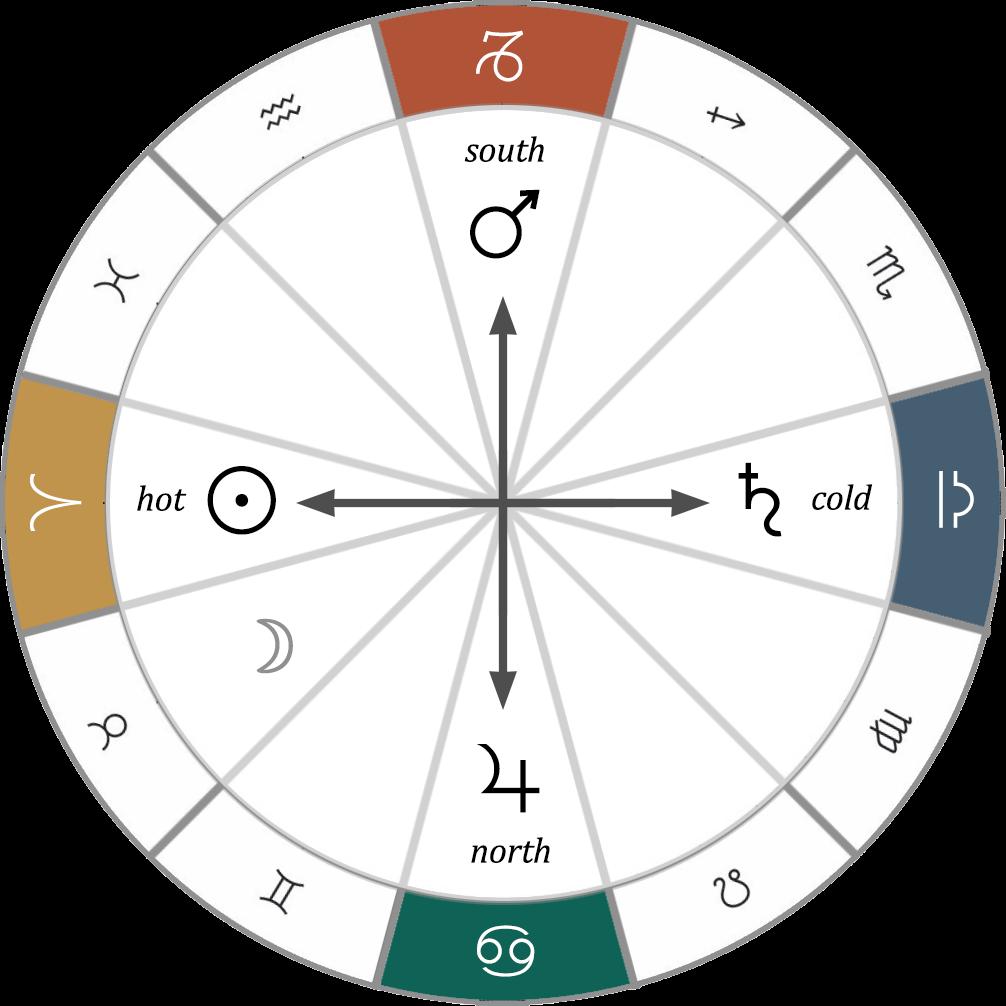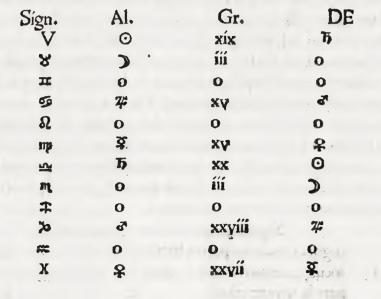Not for lack of theory or proposed conceptual designs, the origin of the exaltation degrees remains as mysterious as Agatha Christie’s disappearance.
The 3rd-century Syrian astrologer, Porphyry, was impressed by the pattern by which the diurnal planets (M, h, i) yield trines between their signs of rulership and exaltation, while the nocturnal planets (c, `, R) yield sextiles. But Porphyry gives no reason for the varying degrees he lists for each planet – why, Porphyry, is the Sun exalted in the 19th degree, the Moon the 3rd, Venus the 27th, &c?

Also, I don’t buy Porphyry’s explanation that Mercury has the same sign for its rulership and exaltation because “its ray is dimmer”.1 He is basically saying that diurnal planets get trines, nocturnal planets get sextiles, and Mercury gets a conjunction. It’s a neat pattern to observe but not a satisfactory explanation.
Planetary exaltations
M ~ 19th degree
R Ä 3rd degree
i Ö 20th degree
h Ç 15th degree
c à 28th degree
`
_
ä 27th degree
Ñ 15th degree
¡ Signs of exaltation for diurnal planets trine a sign of rulership Signs of exaltation for nocturnal planets sextile a sign of rulership ¢
In terms of explanation, we have two models to follow. One views the degrees as recorded positions in a year of special astronomical significance (note: the degrees are describing distinct planetary phenomena within that year, not depicting planetary positions for one moment of time – we can rule that out since Mercury cannot be in Virgo when the Sun is in Aries). The other diverts attention away from the specific degrees, as Porphyry does, and builds a theory that the relationships of the signs reflect some kind of interplay between the planets. Although both models come from different perspectives, they unite in one persuasive detail.


Let’s consider first the proposal of Cyril Fagan, as the leading example of the “recorded positions” theory. In his 1950s book, Zodiacs Old and New, Fagan explained his fascination with a cuneiform tablet from the era of Nebuchadnezzar (604-561 BC), which lists the Moon’s exaltation in the Pleiades. He noted how its position aligned with Moon’s historically reported exaltation in the 3rd degree of tropical Taurus, proving that planetary exaltations were established before the widespread adoption of the tropical zodiac, hence, ruling out any theories that their rationale is based on the relationship of the 12 equal zodiacal signs. The same tablet also records the Sun’s exaltation in the Hireling, the Babylonian constellation later known as Aries.

Fagan realised that the Pleiades was central to the New Year festival in ancient Mesopotamia. Their year began with the first heliacal rising of the Moon after the Sun had returned to the Vernal Equinox,2 and the arc of separation between the Sun and Moon’s exaltation equates to that of the Pleiades from the Sun on the first day of the Babylonian New Year (when the new crescent actually becomes visible). Fagan’s work argues that all of the planetary exaltations line up with important heliacal phenomena from the year 786 BC, which was of commemorative interest to astrology because it saw the official opening in Calah3 of the temple of knowledge dedicated to Nabu Nabu (or Nebo) was represented by the planet Mercury and the Babylonian god of astrology, writing, and wisdom. It is true that the opening of this temple was a huge foundational event in the history of that ancient Babylonian city.
By the time of the ancient Greeks those exaltation were being recorded by some (not all) sources, but without explanation of why the specific degrees matter. If Fagan’s theory, or something like it was correct, this might have been because astrologers of a later era and a different geographic region saw no value in commemorating an event that had no relevance to their own culture.
Now let’s consider the reasoning of the sign arrangement as it was understood by Ptolemy
Ptolemy does not mention or acknowledge the exaltation degrees. However, he does state that the reason the Sun is exalted in Aries is because this is the sign where the Sun crosses the Vernal Equinox to bring the return of spring to the northern hemisphere. So the Sun is exalted in Aries and depressed in its opposite sign, Libra
He adds that the reason the Moon is exalted in Taurus is because this is the sign where it shows its first phase (reappears) after its union with the Sun in Aries. So the logic proposed by Fagan is the same as that recorded by Ptolemy, who adds that the opposite sign, Scorpio, is where the Moon experiences its fall.

From this point on, the explanation moves to a new set of logic that is not embedded in Fagan’s theory – it is based on aligning planets with directions and cardinal signs and contrasting their qualities with each other.
The opposing planetary pairs and qualities are as follows:
heating M opposes fertile / northern h opposes c southern moist/ spring ` opposes _ dry/ autumn
So Saturn, being the opposing quality to the Sun, is exalted in Libra and suffers its fall in Aries – because where the Sun is strong, Saturn is weak, and vice versa

Next we consider that Jupiter is associated with the fecund north wind and Mars with the destructive south wind (remember, this philosophy originated in regions that were hot and arid, where cooling
2 Much like the modern formula for calculating the date of Easter today, which relies on similar reasoning but uses the Full Moon rather than the New Moon. So Easter Sunday is celebrated on the first Sunday following the first Full Moon following the Sun’s return to the Vernal Equinox (now fixed at 0° Aries in the tropical zodiac).
3 Also spelled Kalhu or Kalakh, modern Nimrūd, ancient Assyrian city situated south of Mosul in northern Iraq
winds and rainfall were considered a blessing). This association of Jupiter with the north wind and Mars with the south wind is extremely ancient and derives from Babylonian astrology.4 So, with the first two cardinal signs, Aries and Libra, allocated to the Sun and Saturn, the remaining two cardinal signs are allocated to Jupiter and Mars, in line with the directional associations (Cancer, the northern sign, is given to Jupiter; Capricorn, the southern sign, is given to Mars). Note how these two planets are treated as opposites – so where Jupiter is exalted, Mars is depressed, and vice versa

Only Venus and Mercury remain. These are also treated as opposites. Venus is “moist by nature” and associated with spring, so exercises her power more fully in moist Pisces, a sign of spring. Mercury “is drier” and associated with the autumnal qualities of Virgo. Where Venus is exalted Mercury is depressed, and vice versa
This may seem like an unnecessary detour into an ancient explanation of seven exaltation signs that you can simply remember, but the points expressed in Ptolemy’s passage are pertinent to understanding the Babylonian concepts that underlie the original exaltation arrangement. These details tie into associated philosophies and allow us to build connections with other elements of ancient astrology. I would like to develop this and look at other elements of relevance in a future issue; for now, the emphasis on the contrasting planetary pairs is what I ask you to keep in mind as we consider the design of the planetary falls.
What Ptolemy reports is also expressed in a slightly altered form in the 2nd-century Greek text of Antiochus (Thesaurus I.7) This agrees that the Sun (heat and light), is exalted where Saturn (cold and dark) is depressed, and vice versa. Jupiter (life and abundance) is raised where Mars (overseer of death and) is depressed.

For Mercury and Venus, Antiochus tells us that Venus is exalted in the place that Mercury experiences fall, and vice versa, because Mercury “is the master of dispute” while Venus “is the overseer of desire and intercourse”. So “where the intellectual increases, there the desire and pleasure in intercourse is depressed. And where desire and pleasure are exalted, there the intellect is depressed”.
The Moon is now the odd one out, as Mercury was for Porphyry, so Antiochus ends with a less than satisfactory but rather poetic explanation that the Moon is “the fortune of all” and so “whom fortunes exalts, no one may depress; while he whom fortune depresses, no one is able to exalt”.
Exaltation and fall degrees
“Venus is opposite to Mercury. He comprehends languages and discipline; she delights and pleasures, Jupiter the like to Mars; this coveteth mercy and justice; that, impiety and cruelty”
– Aphorism 3: Hermes Centiloquium www.skyscript.co.uk/centiloquium2.html
So now let’s consider the concept of the falls. Like everyone else, I acquired the understanding that in whatever degree a planet is exalted, the opposite degree is where it experiences its fall. For example, the exaltation of Jupiter is 15° Ç, therefore its fall must be 15° à; the exaltation of Mars is 28° à, therefore its fall must be 28° Ç
4 We see evidence of the north wind being associated with certain months of the year, and certain signs of the zodiac and the region of Akkad (under the influence of Jupiter), and the south wind likewise being associated with signs and months and the region of Elam (under the influence of Mars) from at least the 7th century BC
But think again about what we have been told: the place where Jupiter is exalted is the place where Mars experiences its fall So, if we are considering the specific degrees, and Jupiter is exalted at 15° Ç, then shouldn’t this degree – 15° Ç – be the one where Mars experiences its fall? If Mars is exalted at 28° à, then shouldn’t this same degree be where Jupiter experiences its fall?
This had not occurred to me until I recently worked through a Latin manuscript of Firmicus, which explains and tabulates the degrees of exaltation and fall in this way. This is not how the text reads in the English translations of Jean Rhys Bram or James Holden Holden recorded his suspicion of corruption in the transmission, so he ‘corrected’ the text to agree with Dorotheus. But in this Latin edition, the tabulated information carefully agrees with what is stated in the text – so cannot be dismissed as a careless error. Here is how the passage reads (Mathesis, II.3). This definitely gives new food for thought about the issue, although more research is needed before any firm conclusions are drawn.

EXALTATIONS AND FALLS OF THE PLANETS
We must know about exaltation and debasement – that is, what is the exaltation of each individual planet, in which it is raised up to a maximum of its own natural force, and what is its fall, when it suffers loss of that force.
When planets are in their own exaltations we say that they rejoice. When in a chart the majority of the planets are in the exact degree of their exaltation, they indicate the greatest prosperity. On the other hand, men are overwhelmed by catastrophe when the majority of the planets are located in the exact degree of those signs in which they lose their power by debasement or fall.
The former are called exaltations, or favourable places in the chart, because they make those who are born with this configuration fortunate and successful When they are in their debility or fall, that is, in unfavourable places, they make men wretched, poor, of low birth, and constantly plagued by bad luck.


The Babylonians called the signs in which the planets are exalted their ‘houses’. But in the doctrine we use, we maintain that all the planets are more favourable in their exaltations than in their own signs.
The M is exalted in the 19th degree of ~ but is in its fall in the 20th degree of Ö. The R is exalted in the 3rd degree of Ä, in its fall in the 3rd degree of Ü i is exalted in the 20th degree of Ö, while it is in its fall in the 19th degree of ~ h is exalted in the 15th degree of Ç, but its fall is in the 28th degree of à. c is exalted in the 28th degree of à, but is in its fall in the 28th degree of Ç ` is exalted in the 27th degree of ä, in its fall in the 15th degree of Ñ _ is exalted in the 15th degree of Ñ and is in its fall in the 27th degree of ä Sign Exalt Degree Fall
